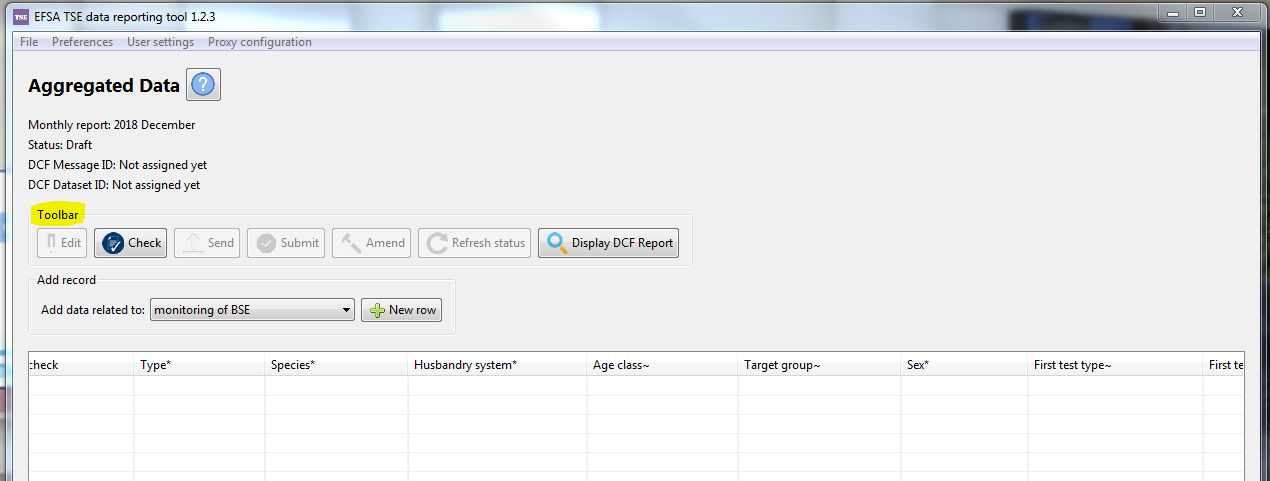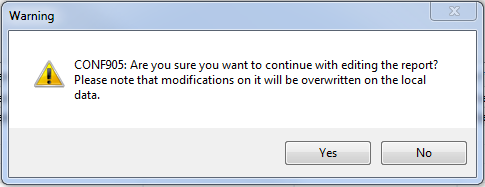-
Notifications
You must be signed in to change notification settings - Fork 6
Toolbar
The TSE data reporting tool allows performing several actions on the monthly reports, simply by pressing the related buttons of the Toolbar placed above the aggregated data table (shown below). Buttons are enabled only when the status of the report allows the required action.

It is possible to modify or add new content to the report only if its status is in Draft. In case it is needed to edit a report, which is in a different status, click on the ![]() Edit button; this action will generate a pop-up warning as the one below:
Edit button; this action will generate a pop-up warning as the one below:

Please note that editing a report already locally validated will allow you to modify its information by overwriting those already existing locally.
The ![]() Check button is active when the report status is Draft and allows to locally validate a report.
Check button is active when the report status is Draft and allows to locally validate a report.
Please note that the validation of the TSE data reporting tool is NOT a replacement of the validation that DCF will conduct by applying certain business rules. For this reason, it is possible that a locally-validated report still can contain errors detected by EFSA's DCF.
More information about this can be found in the section Report Submission.
By clicking on the ![]() Send button, you can upload a Locally validated report to the DCF through the TSE reporting tool. Only reports that have been sent to the DCF are visible to EFSA.
Send button, you can upload a Locally validated report to the DCF through the TSE reporting tool. Only reports that have been sent to the DCF are visible to EFSA.
More information about this can be found in the section Report Submission.
The ![]() Submit button allows you to submit to the EFSA data warehouse (DWH) reports in status Valid or Valid with warnings. Submitted reports can be visualised in MicroStrategy the day after you click the Submit button.
Submit button allows you to submit to the EFSA data warehouse (DWH) reports in status Valid or Valid with warnings. Submitted reports can be visualised in MicroStrategy the day after you click the Submit button.
More information about this can be found in the section Report Submission.
The ![]() Amend button is only supposed to be used in the exceptional case that the data provider needs to correct data which were already in status Accepted DWH. Every time a report is amended, the tool creates a new revision and automatically inserts in DCF the amended records only.
Amend button is only supposed to be used in the exceptional case that the data provider needs to correct data which were already in status Accepted DWH. Every time a report is amended, the tool creates a new revision and automatically inserts in DCF the amended records only.
More information about this can be found in the section Data Amendment.
The ![]() Refresh status button allows the data provider to update the status of the report opened in the TSE data reporting tool. This action is required since the TSE tool does not automatically check the report status in DCF. Thus it is needed after an action that involves a change in the report status is performed (e.g. sending a report, submitting a report).
Refresh status button allows the data provider to update the status of the report opened in the TSE data reporting tool. This action is required since the TSE tool does not automatically check the report status in DCF. Thus it is needed after an action that involves a change in the report status is performed (e.g. sending a report, submitting a report).
More information about this can be found in the section Report Submission.
The ![]() Display DCF Report button allows you to check if the online report is the same version as the one stored locally. There is a number of warning messages that may appear after clicking on this button:
Display DCF Report button allows you to check if the online report is the same version as the one stored locally. There is a number of warning messages that may appear after clicking on this button:
-
"Please be aware that your local dataset is out of date since it has been modified with message lastModifyingMessageId": this case happens when the version of the local dataset is higher than the one retrieved from the DCF. Please check if there are other users working on the same dataset and, in that case, try to work separately. In case you are the only one working on the dataset and you received the message explained above then contact the zoonoses_support
-
"The ack displayed is the last available one. Please REFRESH the STATUS of the dataset": this happens when the message ID received from the DCF has a higher version compared to the local one. In this case, please, refresh the report status.
-
"Dataset still in processing": if this message appears than wait until the Dataset has been analysed. This can be checked by refreshing its status.
-
"The local dataset has not been uploaded yet": in this case, the tool found that both the dataset ID and the message ID retrieved from the DCF are not found into the local database.
Since the TSE tool version 1.3.7, the data provider can export the aggregated data in Excel format.
